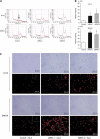Silencing of ferrochelatase enhances 5-aminolevulinic acid-based fluorescence and photodynamic therapy efficacy
- PMID: 21304523
- PMCID: PMC3048207
- DOI: 10.1038/bjc.2011.12
Silencing of ferrochelatase enhances 5-aminolevulinic acid-based fluorescence and photodynamic therapy efficacy
Abstract
Background: Recurrence of glioma frequently occurs within the marginal area of the surgical cavity due to invading residual cells. 5-Aminolevulinic acid (5-ALA) fluorescence-guided resection has been used as effective therapeutic modalities to improve discrimination of brain tumour margins and patient prognosis. However, the marginal areas of glioma usually show vague fluorescence, which makes tumour identification difficult, and the applicability of 5-ALA-based photodynamic therapy (PDT) is hampered by insufficient therapeutic efficacy in glioma tissues.
Methods: To overcome these issues, we assessed the expression of ferrochelatase (FECH) gene, which encodes a key enzyme that catalyses the conversion of protoporphyrin IX (PpIX) to heme, in glioma surgical specimens and manipulated FECH in human glioma cell lines.
Results: Prominent downregulation of FECH mRNA expression was found in glioblastoma tissues compared with normal brain tissues, suggesting that FECH is responsible for PpIX accumulation in glioblastoma cells. Depletion of FECH by small interference RNA enhanced PpIX fluorescence after exposure to 5-ALA concomitant with increased intracellular PpIX accumulation in glioma cells. Silencing of FECH caused marked growth inhibition and apoptosis induction by PDT in glioma cells.
Conclusion: These results suggest that knockdown of FECH is a potential approach to enhance PpIX fluorescent quality for optimising the subjective discrimination of vague fluorescence and improving the effect of 5-ALA-PDT.
Conflict of interest statement
Y Endo obtained the research grant from the company that provided PpIX fluorescence spectral intensity analysis. The other authors declare no conflict of interest.
Figures







References
-
- Angell-Petersen E, Hirschberg H, Madsen SJ (2007) Determination of fluence rate and temperature distributions in the rat brain; implications for photodynamic therapy. J Biomed Opt 12: 014003. - PubMed
-
- Au CM, Luk SK, Jackson CJ, Ng HK, Yow CM, To SS (2006) Differential effects of photofrin, 5-aminolevulinic acid and calphostin C on glioma cells. J Photochem Photobiol B 85: 92–101 - PubMed
-
- Aydin H, Sillenberg I, von Lieven H (2001) Patterns of failure following CT-based 3-D irradiation for malignant glioma. Strahlenther Onkol 177: 424–431 - PubMed
-
- Ennis SR, Novotny A, Xiang J, Shakui P, Masada T, Stummer W, Smith DE, Keep RF (2003) Transport of 5-aminolevulinic acid between blood and brain. Brain Res 959: 226–234 - PubMed
-
- Ferreira GC, Franco R, Lloyd SG, Moura I, Moura JJ, Huynh BH (1995) Structure and function of ferrochelatase. J Bioenerg Biomembr 27: 221–229 - PubMed
Publication types
MeSH terms
Substances
LinkOut - more resources
Full Text Sources
Other Literature Sources

